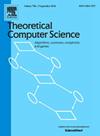Improved FPT approximation scheme and approximate kernel for biclique-free max k-weight SAT: Greedy strikes back
IF 0.9
4区 计算机科学
Q3 COMPUTER SCIENCE, THEORY & METHODS
引用次数: 0
Abstract
In the Max k-Weight SAT (aka Max SAT with Cardinality Constraint) problem, we are given a CNF formula with n variables and m clauses together with a positive integer k. The goal is to find an assignment where at most k variables are set to one that satisfies as many constraints as possible. Recently, Jain et al. [20] gave an FPT approximation scheme (FPT-AS) with running time for Max k-Weight SAT when the incidence graph is -free. They asked whether a polynomial-size approximate kernel exists. In this work, we answer this question positively by giving a -approximate kernel with variables. This also implies an improved FPT-AS with running time . Our approximate kernel is based mainly on a couple of greedy strategies together with a sunflower lemma-style reduction rule.
求助全文
约1分钟内获得全文
求助全文
来源期刊

Theoretical Computer Science
工程技术-计算机:理论方法
CiteScore
2.60
自引率
18.20%
发文量
471
审稿时长
12.6 months
期刊介绍:
Theoretical Computer Science is mathematical and abstract in spirit, but it derives its motivation from practical and everyday computation. Its aim is to understand the nature of computation and, as a consequence of this understanding, provide more efficient methodologies. All papers introducing or studying mathematical, logic and formal concepts and methods are welcome, provided that their motivation is clearly drawn from the field of computing.
 求助内容:
求助内容: 应助结果提醒方式:
应助结果提醒方式:


